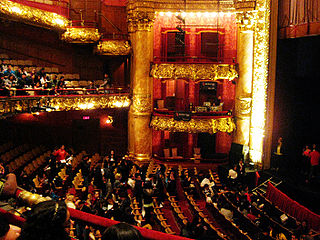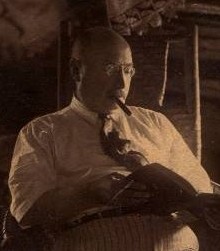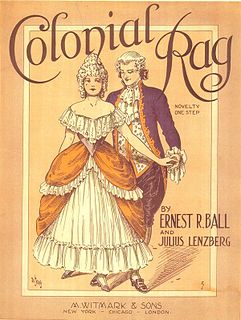Related Research Articles
![Marsha Norman Writer (1947−[[Category:Errors reported by Module String]]String Module Error: Target string is empty)](https://upload.wikimedia.org/wikipedia/commons/thumb/e/ec/Marsha_norman.jpg/265px-Marsha_norman.jpg)
Marsha Norman is an American playwright, screenwriter, and novelist. She received the 1983 Pulitzer Prize for Drama for her play 'night, Mother. She wrote the book and lyrics for such Broadway musicals as The Secret Garden, for which she won a Tony Award and the Drama Desk Award for Outstanding Book of a Musical, and The Red Shoes, as well as the libretto for the musical The Color Purple and the book for the musical The Bridges of Madison County. She is co-chair of the playwriting department at The Juilliard School.

The Palace Theatre is a Broadway theater at 1564 Broadway, facing Times Square, in the Midtown Manhattan neighborhood of New York City. Designed by Milwaukee architects Kirchoff & Rose, the theater was funded by Martin Beck and opened in 1913. From its opening to about 1929, the Palace was considered among vaudeville performers as the flagship of Benjamin Franklin Keith and Edward Franklin Albee II's organization. The theater had 1,743 seats across three levels as of 2018.
NBC Studios are located in the historic 30 Rockefeller Plaza in the borough of Manhattan, New York City. The building houses the NBC television network headquarters, its parent NBCUniversal, and NBC's flagship station WNBC, as well as cable news channel MSNBC.

The Neil Simon Theatre, formerly the Alvin Theatre, is a Broadway theatre built in 1927 and located at 250 West 52nd Street in the Theater District of Midtown Manhattan in New York City.

The Colonial Theatre in Boston, Massachusetts, opened in 1900, is the oldest continually-operating theatre in the city. It is located at 106 Boylston Street on Boston Common at the former site of the Boston Public Library. It is a pending Boston Landmark.
The Adelphi Theatre, originally named the Craig Theatre, opened on December 24, 1928. The Adelphi was located at 152 West 54th Street in Manhattan, with 1,434 seats. The theater was taken over by the Federal Theater Project in 1934 and renamed the Adelphi. The theater was renamed the Radiant Center by The Royal Fraternity of Master Metaphysicians in 1940. It was then the Yiddish Arts Theater (1943), and renamed the Adelphi Theater on April 20, 1944, when it was acquired by The Shubert Organization. Some interiors were decorated with murals painted by Joseph Mortimer Lichtenauer. The artistic cycle was dismembered after its demolition.

The Ed Sullivan Theater is a theater at 1697–1699 Broadway, between 53rd and 54th Streets, in the Theater District of Midtown Manhattan in New York City. Built from 1926 to 1927 as a Broadway theater, the Sullivan was developed by Arthur Hammerstein in memory of his father, Oscar Hammerstein I. The two-level theater was designed by Herbert J. Krapp with over 1,500 seats, though the modern Ed Sullivan Theater seats many fewer people. The neo-Gothic interior is a New York City landmark, and the building is on the National Register of Historic Places.

State Theatre New Jersey is a nonprofit theater, located in New Brunswick, New Jersey. It has seating for 1,850 people. Designed by architect Thomas W. Lamb in 1921, it is one of the oldest theaters in the State of New Jersey.

Walter Hampden Dougherty, known professionally as Walter Hampden, was an American actor and theatre manager. He was a major stage star on Broadway in New York who also made numerous television and film appearances.

The Longacre Theatre is a Broadway theatre made for music and dance located at 220 West 48th Street in Midtown Manhattan.

The Hippodrome Theatre also called the New York Hippodrome, was a theater in New York City from 1905 to 1939, located on Sixth Avenue between West 43rd and West 44th Streets in the Theater District of Midtown Manhattan. It was called the world's largest theatre by its builders and had a seating capacity of 5,300, with a 100x200ft (30x61m) stage. The theatre had state-of-the-art theatrical technology, including a rising glass water tank.

Ken Davenport is a two-time Tony Award-winning theatre producer, blogger, and writer. He is best known for his production work on Broadway.
Reeves Teletape Studios was a group of television studios located in Manhattan in New York City. Owned by Reeves Communications Corporation, it was formed in 1974 by the merger of Reeves Sound Services, and Tele-tape Productions. Unitel Video bought the studio and its assets in late 1986, and operated them until at least 1993.

Four New York City theaters have borne the name Wallack's Theatre. Each has had other names before or after, or both. All are demolished.
Joseph Peter Philip Iconis is an American composer, lyricist, and playwright. He is best known for writing the music and lyrics to the Broadway musical Be More Chill.

The Majestic Theatre was a theatre located at 5 Columbus Circle, the present site of the Time Warner Center in Manhattan, New York City.
The Lillian Booth Actors Home of The Actors Fund is an American assisted-living facility, in Englewood, New Jersey. It is operated by the Actors Fund, a nonprofit umbrella charitable organization that assists American entertainment and performing arts professionals.

Percy Garnett Williams was an American actor who became a travelling medicine salesman, real estate investor, amusement park operator and vaudeville theater owner and manager. He ran the Greater New York Circuit of first-class venues. Williams was known for giving generous pay and good working conditions to performers. At his death, he endowed his Long Island house as a retirement home for aged and destitute actors.

Julius Lenzberg was a German-American composer of ragtime and jazz. He recorded a substantial number of jazz pieces with orchestra between 1919 and 1922, in addition to ragtime music such as his popular Hungarian Rag of 1913.

Daly's Theatre was a Broadway theatre at 1221 Broadway and 30th Street. It was built in 1867 and opened that year as Banvard's Museum but changed its name the following year to Wood's Museum and Metropolitan. In 1876 it became the Broadway Theatre, and finally was named Daly's Theatre in 1879 when it was acquired by Augustin Daly. After 1899, it was operated by the Shubert family. The building was demolished in 1920, after serving as a burlesque theatre and cinema.
References
- 1 2 Aberjhani, and Sandra L. West. 2003. Encyclopedia of the Harlem Renaissance. New York: Facts On File, Inc. ISBN 1438130171. P. 290
- 1 2 3 4 5 6 Krefft, Bryan. "Colonial Theatre", Cinema Treasures. Web. Retrieved October 25, 2014.
- ↑ "Demolished Broadway: Theatres", Musicals101.com, Retrieved October 25, 2014.